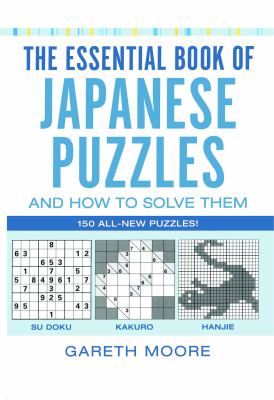4727268
9780743297424
Essential Book of Japanese Puzzles and How to Solve Them
by Moore, Gareth
About this item
- Condition: New
- Provider: LightningBooks
- Provider Rating: 85%
- Ships From: Multiple Locations
- Shipping: Standard, Expedited (tracking available)
- Comments: Fast shipping! All orders include delivery confirmation.

About this item
- Condition: Good
- Provider: Bonita
- Provider Rating: 0%
- Ships From: Multiple Locations
- Shipping: Standard
- Comments: Access codes and supplements are not guaranteed with used items. May be an ex-library book.

Product details
- ISBN-13: 9780743297424
- ISBN: 0743297423
- Publication Date: 2006
- Publisher: Atria Books
AUTHOR
SUMMARY
Su Doku: Introduction If you haven't heard of Su Doku yet then you can't have picked up a newspaper or gone into a bookshop any time recently! It's a number-puzzle game that's simple to play and yet complex to master. Despite using numbers, it doesn't require any math at all -- the only thing needed is a sprinkling of logic. The Su Doku grids in this book are all squares with nine columns and nine rows, as indeed are the vast majority of Su Doku puzzles elsewhere. Unlike some other sources of puzzles, however, they can all be solved without ever requiring any guesswork. Logical deduction from the numbers that are already in the grid is all that is ever needed. This makes the puzzles much more satisfying. So how do you play Su Doku? Easy! Those nine columns and nine rows need to be filled with nine different numbers, 1 to 9, and there is just one trivially simple rule: each number can only be used once per "region." And what is a region? That's easy too: a region is any single row, any single column, OR any of the nine individual 3x3 squares that are marked in the puzzle grid with a heavier line. An example row, column and 3x3 region are marked in this Su Doku puzzle: Look at the square labeled "a." The solution has to be "7" because it's the only place where it can fit on that row, given the restriction that all nine different digits have to be placed into each row. Similarly consider square "b." There's no "4" in this 3x3 region, so that must be the solution. There are various cunning strategies you can use to help you solve the puzzles in this book, but half the fun is working out what they are. One tip is worth passing on, however -- if you get stuck then use a pencil to mark in which numbers can fit in each square. You might notice something new, such as a square where only one number can fit. Good luck! The puzzles in this book get harder as you progress through the section, so if you're finding it tough then try an earlier puzzle. All the solutions are at the back if you get really stuck -- there is a unique solution to each puzzle so if yours differs, then you've gone wrong somewhere! Compilation copyright 2005 by Michael O'Mara Books Limited Puzzles and solutions copyright 2005 by Gareth Moore Hanjie: Introduction Hanjie is a fascinating Japanese picture puzzle that dates back to at least the eighteenth century. It consists of an empty grid that is filled in by following a few simple number clues, gradually revealing a concealed image -- a kind of "painting by numbers." Just by finishing a puzzle you're rewarded with a stylized work of art! How to play Hanjie puzzles consist of a grid of empty white squares, with every row and column in the grid having an adjacent list of one or more numbers -- these are the clues. (In this book, clues for horizontal rows are on the right of the grid, and clues for vertical columns are at the bottom.) Completing the puzzles involves nothing more complex than shading or coloring in the number of squares dictated by each row's or column's list of clues. The twist is that the clues only tell you how many squares to shade in on a line -- it is up to you to work out where they go! A very simple example of a finished puzzle looks like this: Notice how the clue numbers match the filled squares -- the two numbers "1, 1" on the first row show that there are two filled areas of length 1 on that row. On the final row a single "3" indicates that there is a single area of three consecutive filled squares on the row. The initial puzzle grid is empty, and looks like this (the letters against each row are just for the purposes of this description, however -- you won't find them in the actualMoore, Gareth is the author of 'Essential Book of Japanese Puzzles and How to Solve Them', published 2006 under ISBN 9780743297424 and ISBN 0743297423.
[read more]


